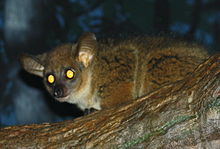Prosimian
| Prosimian Temporal range:
| |
|---|---|

| |
| Tarsiers are prosimian primates, but more closely related to monkeys and apes (simians) than to other prosimians. | |
| Scientific classification | |
| Domain: | Eukaryota |
| Kingdom: | Animalia |
| Phylum: | Chordata |
| Class: | Mammalia |
| Order: | Primates |
| (unranked): | Prosimii Illiger, 1811[a] |
| Groups included | |
| Cladistically included but traditionally excluded taxa | |
|
Simiiformes
| |
Prosimians are a group of
Prosimians are the only primates native to Madagascar, but are also found throughout Africa and in Asia.
Characteristics

Being an
Related to their frequently nocturnal lifestyle, prosimians lack the colour vision of higher primates. Like most placental mammals, they are in effect red–green colour blind. This allows for more rod cells in the retina, which may enhance vision under low-light conditions.[7] Except in tarsiers, the nocturnal vision is further augmented by a reflective tapetum lucidum behind the retina, similar to that found in other nocturnal mammals. This layer reflects the light that passes through the retina, increasing the photoreceptors exposure to the light. It is however not well developed in diurnal forms like many lemurs.[8]
All prosimians possess two laterally flattened
The prosimians have retained the primitive mammalian condition of a bicornuate uterus, with two separate uterus chambers. In the simians, the uterus chambers have fused, an otherwise rare condition among mammals. Prosimians usually have litters rather than single offspring, which is the norm in higher primates.[10]
While primates are often thought of as fairly intelligent animals, the prosimians are not very large-brained compared to other placental mammals. Their brain-cases are markedly smaller than those of simians of comparable sizes. In the large-eyed tarsiers, the weight of the brain is about the same as that of a single eye.[11] Prosimians generally show lower cognitive ability and live in simpler social settings than the simians. The prosimians with the most complex social systems are the diurnal lemurs, which may live in social groups of 20 individuals. The nocturnal prosimians are mainly solitary.[12]
Classification
| Primate phylogeny[13] | ||||||||||||||||||||||||||||||||||||||||||||
| ||||||||||||||||||||||||||||||||||||||||||||
| Prosimians (in green brackets) are a paraphyletic group by including the tarsiers and omomyiforms to the exclusion of the simians (in red brackets). |
The prosimians were once a group considered a suborder of the primate order (suborder Prosimii - Gr. pro, before, + Latin simius/simia, ape), which was named in 1811 by Johann Karl Wilhelm Illiger. They have been shown, however, to be paraphyletic - that is, their most recent common ancestor was a prosimian but it has some non-prosimian descendants (i.e. monkeys and apes). This relationship is shown by the ranks (prosimians in bold) in the list below of the current primate classification between the order and infraorder level. The term "prosimian" is considered taxonomically obsolete,[14] although it is used to emphasize similarities between strepsirrhines, tarsiers, and the early primates.[15]
- Order Primates
- Suborder Strepsirrhini: non-tarsier prosimians
- Infraorder †Adapiformes: extinct "lemur-like" primates
- Infraorder Lemuriformes: lemurs, lorises, and bushbabies[b]
- Suborder Haplorrhini: tarsiers, monkeys and apes
- Infraorder †Omomyiformes: extinct "tarsier-like" primates
- Infraorder Tarsiiformes: tarsiers
- Infraorder Simiiformes: New World monkeys, Old World monkeys, apes, and humans
- Infraorder †
- Suborder Strepsirrhini: non-tarsier prosimians
See also
Notes
- ^ The division of the order Primates into two evolutionary grades, Prosimii ("lower primates") and Anthropoidea ("higher primates") is sometimes used, but has been shown through morphological and genetic evidence to be incorrect. Alternatively, a three-way split in the order Primates—Prosimii, Tarsiiformes, and Anthropoidea—has also been suggested.[1]
- ^ a b Although the monophyletic relationship between lemurs and lorisoids is widely accepted, their clade name is not. The term "lemuriform" is used here because it derives from one popular taxonomy that clumps the clade of toothcombed primates into one infraorder and the extinct, non-toothcombed adapiforms into another, both within the suborder Strepsirrhini.[2][3] However, another popular alternative taxonomy places the lorisoids in their own infraorder, Lorisiformes.[4]
References
- ^ Rose 2006, p. 166.
- ^ Szalay & Delson 1980, p. 149.
- ^ Cartmill 2010, p. 15.
- ^ Hartwig 2011, pp. 20–21.
- ^ ISBN 978-0-202-30658-2.
- ^ Cawthon Lang KA. 2005 July 18. Primate Factsheets: Owl monkey (Aotus) Taxonomy, Morphology, & Ecology. Accessed 2012 July 25.
- ISBN 978-0-306-42065-8.
- S2CID 53156761.
- PMID 9924135.
- ISBN 978-0801862519.
prosimians uterus placenta.
- S2CID 3905636.
- PMID 21357224. Archived from the original(PDF) on 2011-10-03. Retrieved 2011-07-04.
- ^ Rose 2006.
- S2CID 10869981.
- ^ Hartwig 2011, p. 28.
Literature cited
- Cartmill, M. (2010). "Chapter 2: Primate Classification and Diversity". In Platt, M.; Ghazanfar, A (eds.). Primate Neuroethology. Oxford University Press. pp. 10–30. ISBN 978-0-19-532659-8.
- Hartwig, W. (2011). "Chapter 3: Primate evolution". In Campbell, C. J.; Fuentes, A.; MacKinnon, K. C.; Bearder, S. K.; Stumpf, R. M (eds.). Primates in Perspective (2nd ed.). Oxford University Press. pp. 19–31. ISBN 978-0-19-539043-8.
- Rose, K. D. (2006). The Beginning of the Age of Mammals. Johns Hopkins University Press. ISBN 978-0-8018-8472-6.
- Szalay, F.S.; Delson, E. (1980). Evolutionary History of the Primates. OCLC 893740473.
